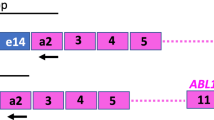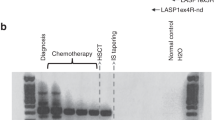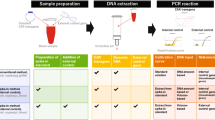Abstract
To analyze the value of real time RT-PCR for monitoring of bcr-abl expression in CML patients after allogeneic or autologous stem cell transplantation (SCT), we generated pairs of PCR-primers and TaqMan probes specific for either the b2a2- or the b3a2-variant of bcr-abl. Either variant could be detected specifically from cDNA from a single K562 (b3a2) and BV173 (b2a2) cell with the respective TaqMan probe. Bcr-abl expression was normalized by comparison with GAPDH expression, and samples were quantitated using standard cDNA dilutions from K562 or BV173 cells. In a retrospective analysis 13 patients with CML after allogeneic (n = 10) or autologous (n = 3) SCT including patients with relapsed or persistent CML were analyzed by both real-time and conventional nested RT-PCR. In addition chimerism was monitored by FISH analysis of sex chromosomes in three patients with relapsed disease. The bcr-abl/GAPDH ratio dropped at least 1000-fold in all seven patients evaluable prior to and after allogeneic SCT as estimated by real-time RT-PCR, and conventional RT-PCR became negative in 6/7 patients. In five patients with relapsed or persistent disease after allogeneic SCT the bcr-abl/GAPDH ratio eventually increased again, and real-time RT-PCR was as sensitive as conventional RT-PCR for detection of bcr-abl. Donor lymphocyte infusions (DLI) were given to all five patients, and the bcr-abl/GAPDH ratio dropped to undetectable levels in two patients both remaining in continuing molecular remission. In contrast, in three other patients the bcr-abl/GAPDH ratio decreased only or did not change significantly after DLI. In three patients undergoing autologous SCT the bcr-abl/GAPDH ratio dropped only 1.1 to 30-fold, and the patients were tested positive with real-time RT-PCR at all time points. These data demonstrate that real-time RT-PCR is valuable to quantitate bcr-abl expression in CML patients after transplantation.
This is a preview of subscription content, access via your institution
Access options
Subscribe to this journal
Receive 12 print issues and online access
$259.00 per year
only $21.58 per issue
Buy this article
- Purchase on Springer Link
- Instant access to full article PDF
Prices may be subject to local taxes which are calculated during checkout
Similar content being viewed by others
Author information
Authors and Affiliations
Rights and permissions
About this article
Cite this article
Eder, M., Battmer, K., Kafert, S. et al. Monitoring of BCR-ABL expression using real-time RT-PCR in CML after bone marrow or peripheral blood stem cell transplantation. Leukemia 13, 1383–1389 (1999). https://doi.org/10.1038/sj.leu.2401489
Received:
Accepted:
Published:
Issue Date:
DOI: https://doi.org/10.1038/sj.leu.2401489
Keywords
This article is cited by
-
Stable RNA interference (RNAi) as an option for anti-bcr-abl therapy
Gene Therapy (2005)
-
HLXB9 activates IL6 in Hodgkin lymphoma cell lines and is regulated by PI3K signalling involving E2F3
Leukemia (2005)
-
BCR-ABL transcripts are early predictors for hematological relapse in chronic myeloid leukemia after hematopoietic cell transplantation with reduced intensity conditioning
Leukemia (2004)
-
Preemptive treatment of minimal residual disease post transplant in CML using real-time quantitative RT-PCR: a prospective, randomized trial
Bone Marrow Transplantation (2004)
-
TaqMan RT-PCR assay coupled with capillary electrophoresis for quantification and identification of bcr-abl transcript type
Modern Pathology (2004)



